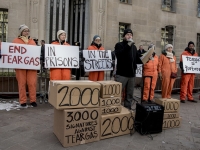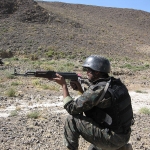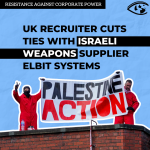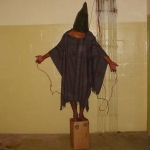Who Manufactures the Riot Control Weapons Used on Black Lives Matter Protestors?

Last month thousands of Black Lives Matter activists gathered peacefully outside the White House in Washington D.C. to protest the killing of George Floyd. They were met with unexpected force as police dispersed them with tear gas and flash bangs so that President Donald Trump could conduct a photo-op.
Night after night, across the country, protestors met with the same heavy-handed response with so-called ‘non-lethal’ technology such as tear gas, pepper spray, rubber bullets and batons, drawing comparisons with law enforcement attacks in recent years on Black Lives Matter protests in Ferguson, Missouri; the Standing Rock protests against the Dakota Access Pipeline asylum; and not least asylum seekers on the U.S.-Mexico border, including children. (The New York Times documented the use of tear gas at George Floyd protests in some 100 cities).
What is tear gas? Tear gas is a common name for a family of chemical irritants. These irritants are not actually gaseous but fine powders dispersed by spray or aerosol. Tear gas doesn’t just make your eyes water; it causes a burning sensation, breathing problems, chest pain and skin irritation. It can lead to nausea and vomiting. It was initially developed by the French around the time of the First World War, and was quickly adopted by the Germans and U.S. as a crowd control device because it was seen as less damaging or deadly than mustard or sarin gas. “When the war ended, all these chemists and chemical companies had been enlisted in the war effort,” says Feigenbaum. “There was this desire to continue these industries during peacetime. In the US, it was marketed as war gases for peacetime use.” Despite the common usage of tear gas by law enforcement personnel, it has been categorized as a chemical weapon under the 1993 Chemical Weapons Convention that nearly every nation has signed, including the United States. Ironically, even though tear gas is banned for use in war under the Treaty, it is not prohibited for use domestically. In recent years examples of unintended damage from tear gas on protesters around the world have been well documented. In Gaza in 2018, a young man was hit in the face with a tear gas canister which lodged into his lower jaw for 45 minutes where it then released its contents directly into his body. “I thought it was called tear gas; I had no idea it was called ‘choke you to death and run around blindly gas,’" Noor Noor, a 28 year old student from Cairo, Egypt, told Public Radio International. Noor’s experience with tear gas comes from his participation in his country’s 2011 uprisings. “The tear gas canisters kind of look like soda cans from a distance — silver, round,” Noor said. “A pastime activity for some people during the clashes was to pick up these tear gas canisters and read who is the country that has supplied these weapons to try and kill us. So, ‘Ah, look, this is American tear gas,' or, "This is British tear gas," or, 'Oh no, they're cheap, and they’re using Chinese tear gas now; they want to kill us.’” Jamil Dakwar, the director of the human rights program at the American Civil Liberties Union (ACLU), says that his organization has been concerned about the use of tear gas for a long time, and that these concern have been amplified during the Covid-19 pandemic, because the irritants produce additional health risks, especially to the lungs. "It creates a severe health risk to people who are subject to it," Dakwar told CBS MoneyWatch. "We have been contacted by a number of members of Congress to look at the way tear gas is being used." Perhaps somewhat surprisingly, even Heal, the policing expert, agrees. “I don't like it; it has all kinds of problems. It's not an ideal. it's just better than the alternative. People forget: The standard is not perfection. The standard is the alternative, and many times, the alternative is lethal force.” The perfect nonlethal weapon, according to Heal, is one that is capable of discrimination. It needs to be capable of deciphering within a crowd who the target is, and be able to correctly distribute the proper level of dose based on age, height, or health status, all without changing the overall atmosphere or producing lasting effects. Unfortunately, no such thing exists.
|
These attacks share more than just a pattern of alleged police misbehavior – the equipment used can be traced back largely to two companies, according to CBS MoneyWatch: Defense Technology, owned by Safariland, and Combined Systems Inc, owned by New York Private equity firm Point Lookout Capital Partners, the two largest players in the United States.
While the U.S. federal government has no system in place to track law enforcement use of tear gas, a quick review of federal spending conducted by MoneyWatch indicated that Safariland and two of its distributors have received more than $137 million in contracts from the U.S. government within the last three and a half years. (This was to buy products like tear gas, which retails for about $26 per canister.)
Manufacturers claim that their products have helped restore law and order. “If you look around the world from Paris to Hong Kong to Chile, in the absence of these less-lethal products the results would be quite different,” Warren Kanders, CEO of Safariland, told the Financial Times recently.
Policing experts support his point of view. “Tear gas has been a godsend in that it's truly nonlethal. It's very, very difficult to kill somebody,” Sid Heal, a nonlethal weapons expert with more than 30 years experience between the Marine Reserves and Los Angeles County Sheriff’s Department, who has made it his life goal to expand nonlethal options for law enforcement agencies, told the Pittsburgh Post-Gazette.
But other researchers disagree. “The idea that a weapon can be nonlethal is ridiculous,” Anna Feigenbaum, author of Tear Gas, From the Battlefields of WWI to the Streets of Today, told Public Radio International. “To say that something which was designed to cause sensory torture and inflict pain, that we know has caused a lot of death, and that it’s actual, real-world use reveals it to be something that easily can be lethal, means certainly that calling it nonlethal should not be legal.”
(Full disclosure: Feigenbaum has written for CorpWatch in the past.)
The blowback from public exposure of the buyers of these weapons has caused Kander to retreat from the industry.
For example, in November of 2018, tear gas canisters with Defense Technology’s logo were found at the U.S./Mexico border after being used on a caravan of asylum seekers, including children.
At the time Kander was vice chairman of the board of the Whitney Museum of American Art.
Over 100 employees from the museum wrote an open letter to its president decrying Kander’s connection. "First and foremost, some of us are deeply connected to the communities that are being directly impacted and targeted by the tear gassing at the border. For the Whitney not to acknowledge that this news may impact its staff is to assume we are separate from the issue, that it is happening somewhere else to some other people," the letter read.
Eight artists also pulled their work from the museum, forcing Kander to resign from his position on the board at the time.
Kander was back in the news after the Washington D.C. protests at the beginning of June. A CBS News reporter found a canister of Spede-Heat, a tear gas device manufactured by Defense Technology. (Safarilands website warns that "serious injury or death may result", should a Spede-Heat canister be fired directly at a person.)
Just days after the outcry of his role, Kanders decided to sell off the weaponized arm of the company.
“This divestiture removes the active component and allows Safariland to focus on passive defensive protection,” Kanders said in a press release.
Political pressure is now ramping up to force the police to stop buying and using tear gas on protestors. Last month, a group of lawmakers in the U.S. Congress – including Alexandria Ocasio-Cortez of New York and Jesus “Chuy” Garcia of Chicago – proposed a bill that intends to curb police agencies' use of tear gas by denying them federal funding.



